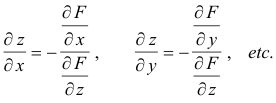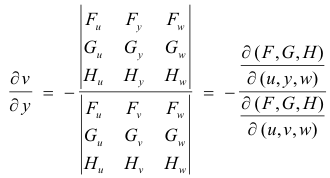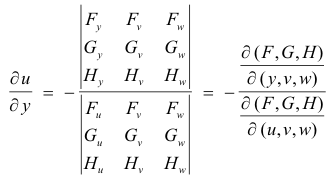
Website owner: James Miller
IMPLICIT FUNCTIONS, DERIVATIVES OF IMPLICIT FUNCTIONS, JACOBIAN

Implicit functions. Let y be related to x by the equation
(1) f(x, y) = 0
and suppose the locus is that shown in Figure 1. We cannot say that y is a function of x since at a particular value of x there is more than one value of y (because, in the figure, a line perpendicular to the x axis intersects the locus at more than one point) and a function is, by definition, single-valued. Although equation (1) above does not define y as a function of x, we can say that on certain judiciously chosen segments of the locus y can be considered to be a single-valued function of x [expressible as y = f(x)]. For example, the segment P1P2 could be separated out as defining a function y = f(x). As a consequence, it is customary to say that equation (1) defines y implicitly as a function of x; and we refer to y as an implicit function of x.
Def. Implicit function. A function defined by an equation of the form f(x, y) = 0 [in general, f(x1, x2, ... , xn) = 0 ]. If y is thought of as the dependent variable, f(x, y) = 0 is said to define y as an implicit function of x.
James and James. Mathematics Dictionary.
Derivatives and implicit functions. Consider the locus of f(x, y) = 0 shown in Fig. 1. Let us ask the following question: “At a particular point on the locus what is the value of the quantity dy/dx?” This question can be answered at all points on the locus except points P1, P2, P3 and P4 (at these points the quantity dy/dx does not exist – it becomes infinite) and the answer is:

If we have an equation of the type f(x, y) = 0, and certain conditions are met, we can view one of the variables as a function of the other in the vicinity of a particular point (x0, y0) that satisfies the equation. The conditions that must be met are stated in the implicit function theorem.
Implicit-function theorem. A theorem stating conditions under which an equation, or a system of equations, can be solved for certain dependent variables. For a function of two variables, the implicit-function theorem states conditions under which an equation in two variables possesses a unique solution for one of the variables in a neighborhood of a point whose coordinates satisfy the equation. Tech. If F(x, y) and DyF(x, y), the partial derivative of F(x, y) with respect to y, are continuous in the neighborhood of a point (x0, y0) and if F(x0, y0) = 0 and DyF(x0, y0) ≠ 0, then there is a number ε > 0 such that there exists one and only one function f which is such that y0 = f(x0) and which is continuous and satisfies F[x, f(x)] = 0 for |x - x0| < ε.
Example. x2 + xy2 + y - 1 and its partial derivative with respect to y, namely 2xy + 1, are both continuous in the neighborhood of (1, 0), and x2 + xy2 + y - 1 = 0 while 2xy + 1 ≠ 0 when x = 1, y = 0. Hence there exists a unique solution for y, in the neighborhood of (1, 0), which gives y = 0 for x = 1.
James and James. Mathematics Dictionary
Def. Jacobian of two or more functions in as many variables. For the n functions fi(x1, x2, ... , xn), i = 1,2, ... , n, the Jacobian is the determinant

It is often denoted by

General implicit-function theorem. The general implicit-function theorem states conditions under which a system of n equations in n dependent variables and p independent variables possesses solutions for the dependent variables in the neighborhood of a point whose coordinates satisfy the given equations. Consider a system of n equations with the n + p variables
u1, u2, ..., un, and x1, x2, ... , xp
namely
f1(x1, x2, ... , xp; u1, u2, ..., un) = 0
f2(x1, x2, ... , xp; u1, u2, ..., un) = 0
...........................................
fn(x1, x2, ... , xp; u1, u2, ..., un) = 0 .
Suppose that these equations are satisfied for the values x1 = x10, ... , xp = xp0, u1 = u10, ... , un = un0, that the functions fi are continuous in the neighborhood of this set of values and possess first partial derivatives which are continuous for this set of values of the variables and, finally, that the Jacobian

of these functions does not vanish for x1 = x10, ... , xp = xp0, u1 = u10, ... , un = un0. Under these conditions there exists one and only one system of continuous functions,
u1 = Φ1(x1, x2, ... , xp)
u2 = Φ2(x1, x2, ... , xp)
................................
un = Φn(x1, x2, ... , xp)
defined in some neighborhood of
(x10, x20, ..... , xp0),
which satisfy the above equations and which reduce to u10, u20, ..... , un0 for x1 = x10, x2 = x20... , xp = xp0.
James and James. Mathematics Dictionary
Differentiation of implicit functions. If we have an equation such as f(x, y, ... , u) = 0 which defines a variable as a function of others implicitly, there are two techniques for computing derivatives.
1. Direct differentiation. Given a particular variable to be considered as the dependent variable, if it is possible to solve the equation for the dependent variable in terms of the independent variables, we can compute the derivative directly by formula.
Example. Compute dy/dx for the equation y - 3x2 + 5x + 1 = 0 . Solution. Solve the equation for y to get
y = 3x2 -5x -1
and compute the derivative directly as dy/dx = 6x - 5.
2. Implicit differentiation. Decide which variable is to be considered the dependent variable and which the independent. Say y is to be considered the dependent variable in f(x, y) = 0. Regarding y as the dependent variable, differentiate the equation as it stands with respect to the independent variable x and then solve the resulting relation for dy/dx. This method is known as implicit differentiation.
Example. Compute dy/dx for the equation x5 + x2y3 - y6 + 7 = 0 .
Solution. Differentiating implicitly, we get

![]()
Solving this for dy/dx gives

Because in most cases it is difficult or impossible to solve for the dependent variable, we usually use the method of implicit differentiation.
Theorem. In the equation f(x, y) = 0 which defines y as a function of x implicitly, the derivative dy/dx is given in terms of the partial derivatives of f(x, y) by

Proof. The total differential of the function z = f(x, y) is given by

If we make the constraint that z = f(x, y) = 0 (i.e. the values of x and y are restricted to the solution set of f(x, y) = 0), then z is constant, dz is zero, and the total differential becomes

So, solving for dy/dx, we get

Partial derivatives of implicit functions. Let two or more variables be related by an equation of type
F(x, y, z, ...) = 0 .
Providing the conditions of the implicit-function theorem are met, we can take one of the variables and view it as a function of the rest of the variables. If we pick z as the dependent variable, the partial derivatives of z with respect to the other variables are given by

Proof. Th proof is essentially the same as the proof above for the case f(x, y) = 0 since all variables except the two in question are treated as constants when taking the partials..
Systems of equations.
Problem. Given the system of equations
F(u, v, w, x, y) = 0
G(u, v, w, x, y) = 0
H(u, v, w, x, y) = 0
find
![]()
considering x and y as independent variables and u, v, w as dependent variables.
Solution. If the conditions given by the implicit-function theorem are met we can view three of the variables, such as u, v and w, as defined implicitly as functions of the other two variables, in the vicinity of a particular point (u0, v0, w0, x0, y0) that satisfies the equations. From 3 equations in 5 variables, we can (theoretically at least) determine 3 variables in terms of the other 2. Thus 3 variables are dependent and 2 are independent. The total differentials of the functions F, G and H are given by
dF = Fudu + Fvdv + Fwdw + Fxdx + Fydy = 0
dG = Gudu + Gvdv + Gwdw + Gxdx + Gydy = 0
dH = Hudu + Hvdv + Hwdw + Hxdx + Hydy = 0 .
Dividing these three equations through by dy, and remembering that x is held constant, we obtain the following system of equations that must be satisfied:
Fuuy,+ Fvvy + Fwwy + Fy = 0
Guuy,+ Gvvy + Gwwy + Gy = 0
Huuy,+ Hvvy + Hwwy + Hy = 0
where Fu represents the partial derivative of F with respect to u, uy, represents the partial derivative of u with respect to y, etc. Solving this system by Cramer’s rule we get

If instead of vy we wanted uy, it would be given by

These results apply to any number of equations or variables.
References.
James and James. Mathematics Dictionary.
Oakley. The Calculus (COS).
Spiegel. Advanced Calculus.
Jesus Christ and His Teachings
Way of enlightenment, wisdom, and understanding
America, a corrupt, depraved, shameless country
On integrity and the lack of it
The test of a person's Christianity is what he is
Ninety five percent of the problems that most people have come from personal foolishness
Liberalism, socialism and the modern welfare state
The desire to harm, a motivation for conduct
On Self-sufficient Country Living, Homesteading
Topically Arranged Proverbs, Precepts, Quotations. Common Sayings. Poor Richard's Almanac.
Theory on the Formation of Character
People are like radio tuners --- they pick out and listen to one wavelength and ignore the rest
Cause of Character Traits --- According to Aristotle
We are what we eat --- living under the discipline of a diet
Avoiding problems and trouble in life
Role of habit in formation of character
Personal attributes of the true Christian
What determines a person's character?
Love of God and love of virtue are closely united
Intellectual disparities among people and the power in good habits
Tools of Satan. Tactics and Tricks used by the Devil.
The Natural Way -- The Unnatural Way
Wisdom, Reason and Virtue are closely related
Knowledge is one thing, wisdom is another
My views on Christianity in America
The most important thing in life is understanding
We are all examples --- for good or for bad
Television --- spiritual poison
The Prime Mover that decides "What We Are"
Where do our outlooks, attitudes and values come from?
Sin is serious business. The punishment for it is real. Hell is real.
Self-imposed discipline and regimentation
Achieving happiness in life --- a matter of the right strategies
Self-control, self-restraint, self-discipline basic to so much in life